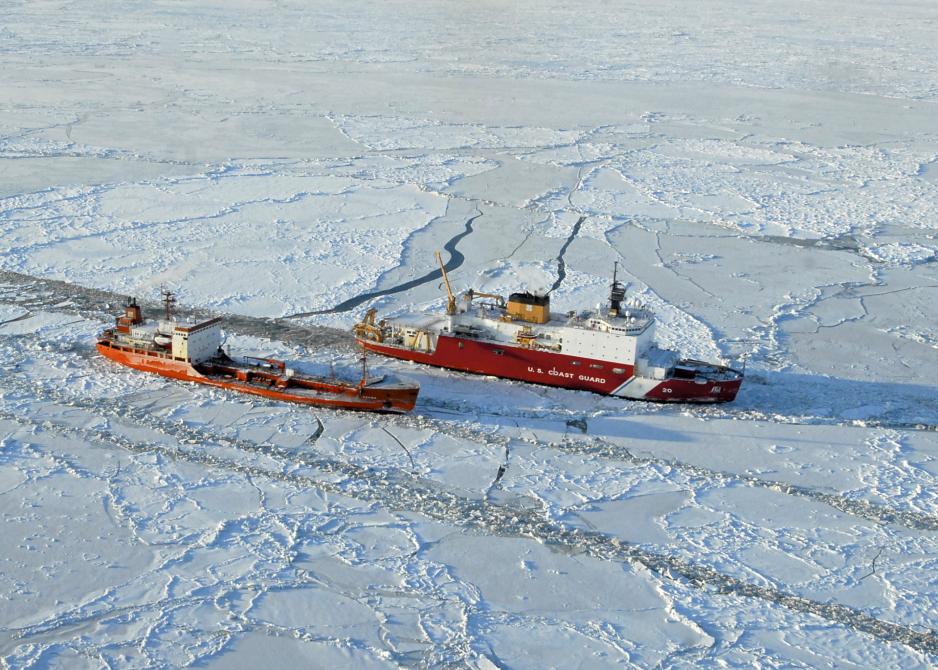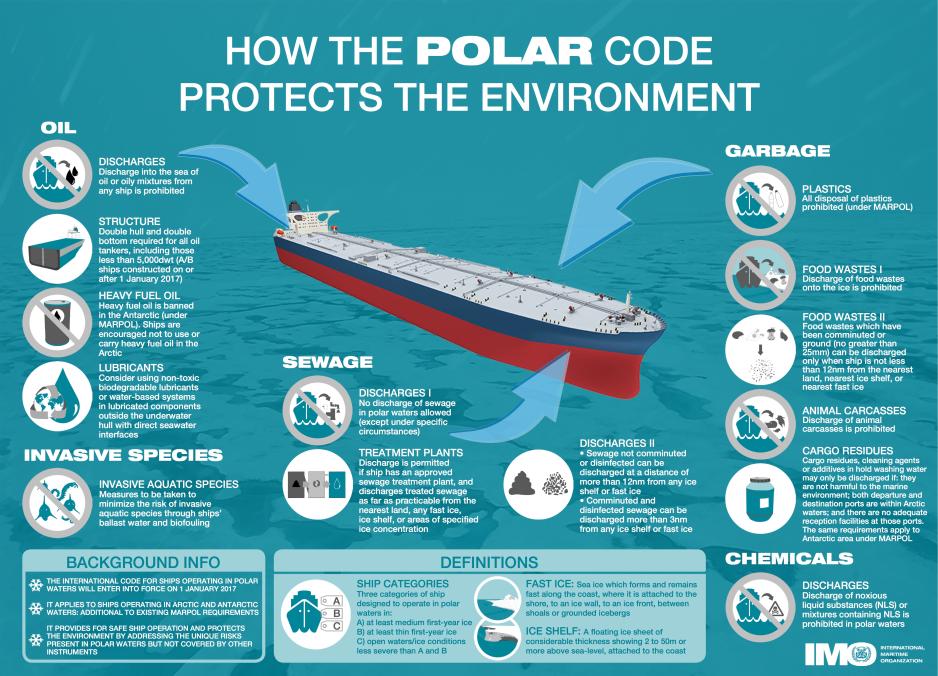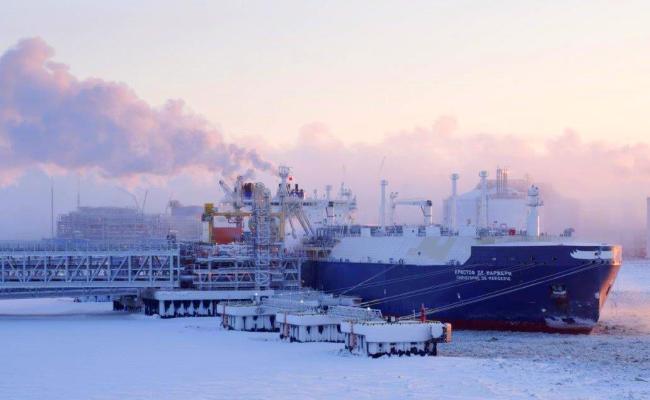Environmental Groups Push For Stronger Polar Code

The ice-strengthened Russian oil tanker Renda, in the foreground, is escorted by the U.S. Coast Guard cutter Healy. (Credit: U.S. Coast Guard/Petty Officer 1st Class Sara Francis)
When the Polar Code takes effect in January 2017, it will strengthen the rules for many of the vessels sailing through Arctic waters. It will help protect the Arctic environment, but experts say gaps remain.
The first ever global framework governing commercial shipping in polar zones isn’t even in effect, yet activists and scientists are already pushing for stronger environmental protections.
The International Code for Ships Operating in Polar Waters, known as the “Polar Code”, was adopted in a series of votes by the International Maritime Organization (IMO) in 2014 and 2015. The agreement, much of which enters force in January 2017, establishes standards for ships operating in the icy waters of the Arctic and Antarctic.
“We are calling it a first phase. Not everyone does,” said Andrew Dumbrille, WWF-Canada’s oceans and Arctic manager.
Large vessels only
Environmental groups have praised the IMO and industry stakeholders for negotiating a binding framework where previously there was none, but they continue to push for a broader regime that covers more maritime activity and adds further environmental protections, said Dumbrille.

Infographic from IMO about the Polar Code.
The Polar Code amends the International Convention on the Safety of Life at Sea (SOLAS) and its corresponding pollution conventions. But SOLAS applies only to large vessels of 500 gross tons and more.
That distinction means tankers, bulk carriers and cruise ships fall under the Polar Code regulations, while fishing boats, yachts and smaller adventure vessels do not, which left environmental groups dissatisfied.
Difficult to agree
“Right now the conversation around the Polar Code is whether to include non-SOLAS vessels. People are scratching their heads as to how you would actually apply it to fishing vessels. I think there is a broad understanding that it needs to happen,” said Dumbrille.
The challenge with fishing boats, Dumbrille said, is that home nations generally try to keep a firm grasp on regulation of their own fleets, making international agreements more difficult.

Maritime Organization limits. (Source: Arctic Portal)
The environmental protocols ban discharges of oil, oily mixtures, plastics and noxious chemicals from ships traveling north of a boundary that ranges between 58 degrees North and 73 degrees North. In North America, the rules are in effect above 60 degrees North.
Ban against sewage
Most sewage and food wastes cannot be dumped overboard within 12 nautical miles of an ice shelf – a thick, floating ice sheet attached to the coast.
Dumbrille said there should be a complete ban on discharging untreated sewage. The code also lacks curbs on the release of “gray water,” or non-sewage waste water from sinks, showers and clothes washing. Some vessels can store sewage and gray water on board for long periods, but others would need to install larger tanks or treatment systems.
Ecologists were disappointed that the Polar Code did not ban ships from using heavy fuel oil (bunker fuel) in the Arctic or carrying it as cargo. Burning heavy fuel oil (HFO) creates black carbon (fine soot) that speeds up melting when it falls on snow and ice. Unlike other fuels, HFO does not evaporate, but sticks to feathers and fur and can smother organisms.
Could be costly
Dumbrille said Russia, in particular, blocked the measures because its northernmost communities tend to use heavy oil to generate electricity. Communities in Alaska, Canada and Scandinavia are more likely to use cleaner diesel fuel.
A spill like that in the wrong place at the wrong time can be pretty devastating
Even so, a spill could be costly.
“I still believe that the first thing that is going to happen is a diesel release from a tourist vessel that wants to get just a little bit closer and closer to see the spectacular flora and fauna, and runs aground in a shallow area,” said Christopher Reddy, a marine chemist at Woods Hole Oceanographic Institution in Massachusetts.
Complex process
“A spill like that in the wrong place at the wrong time can be pretty devastating.”
Policymakers should rely on science to identify sensitive areas and do what’s necessary to minimize the likelihood of a spill there, Reddy said.
It is a complex process to pinpoint the most vulnerable feeding, calving, migration and bird zones in polar regions, where the climate evolves rapidly.
Also read
May change fast
“I do not think we have a good baseline in understanding these habitats and habitat sensitivities for the Arctic,” he added.
“A place that is a very good breeding ground today might be very different five years from now.”
The Polar Code’s vessel safety standards include the need for ice-strengthened hulls, properly trained ice navigators, mandatory cold-weather gear and customized safe-voyage plans.
Historic
Even if certain pollutants are not banned, these shipbuilding and operational requirements reduce the risk of an oil spill, said Lawson Brigham, a former U.S. Coast Guard icebreaker commander who is now a professor of geography and Arctic policy at the University of Alaska Fairbanks.
"The Polar Code is a historic and seminal marine safety and protection regime for the polar waters," Brigham said.
There is a huge infrastructure gap.
“The No.1 thing that is needed to be done is to create a framework to move forward. It’s not as comprehensive as some might like (but) it deals with the prevention side and preventing (spills) from happening.”
Huge gap
Reddy and Brigham noted that an immediate concern is the lack of emergency assets in the vast seas. Very little equipment is available for spill containment, search and rescue, salvage or ship repair.
"There is a huge infrastructure gap," Brigham said.
At IMO sessions later this year, the World Wide Fund for Nature (WWF) and other participants intend to hold side meetings to discuss strengthening ecological safeguards and offering indigenous peoples a greater voice. Dumbrille said native villages need better protection from spills and more clean-up equipment.
"We need to empower and train and put resources in local communities,” he said. “Ultimately they are the first responders. It’s going to wash up on their shores and impact what they eat."
This article originally appeared on Arctic Deeply, and you can find the original here. For important news about Arctic geopolitics, economy, and ecology, you can sign up to the Arctic Deeply email list.

